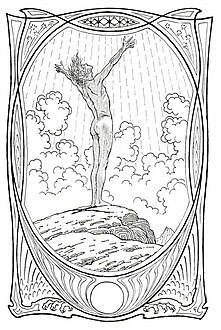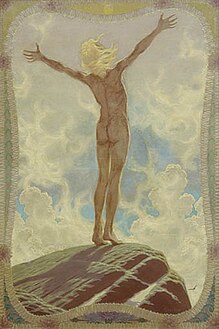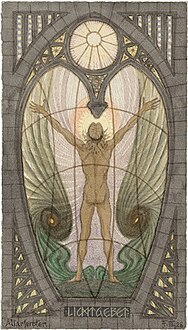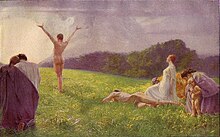
Light Prayer (German: Lichtgebet) is a painting associated with the German Youth Movement and Lebensreform concept of the late 19th and early 20th centuries. It portrays a young, naked man who stands on a rock and stretches his arms toward the sky. It was created by the German painter Fidus, who from 1890 to 1938 made eleven versions in various media. In 1913, he created a postcard based on the painting that became widely spread in Germany.
Fidus wanted to revitalize society through his paintings and implemented Lebensreform themes such as naturism, light, nature and vitality. Light Prayer is in line with the Youth Movement's programme but also became popular among young people who did not associate it with any particular ideology. Scholars have described possible influences from völkisch occultism, the Norwegian landscape, an idea of universal animation, Anthroposophy, Theosophy, evolution theory and a desire to return to nature. The man's posture has been associated with Guido von List's idea of the Algiz (ᛉ) rune as a life symbol and with the image of the crucifixion.
Background
The German painter and draughtsman Hugo Höppener (1868 – 1948) studied at the Academy of Fine Arts in Munich from 1887, quickly took interest in the Lebensreform (transl. life reform) movement and became a disciple of the artist and social reformer Karl Wilhelm Diefenbach. Diefenbach gave him the name Fidus which is Latin for "the faithful one". Together with two other artists, they briefly lived in a naturist commune, inspired by Heinrich Pudor's theories about nudity as a means for increased harmony, honesty and simplicity. Fidus adopted a Theosophical worldview and became a member of Munich's Theosophical society in 1898.
As a painter, Fidus had the ambition to revitalize society and he described himself as a "man of revelation" (German: Offenbahrungsmensch). He employed Romantic and Germanic subjects in a style influenced by symbolism and Jugendstil to create utopian and völkisch images. He incorporated Lebensreform themes, notably nudism and naturism. Related to the Lebensreform concept were the German Youth Movement and Wandervogel groups, where light, fire and the summer solstice frequently were associated with closeness to nature and vitality, and regarded as important in the search for a new sacrality.
Subject and composition
In Light Prayer, a naked young man with a slim body is seen half from behind. He stands on a rock with his heels raised, facing the sky with his arms stretched out. The wind blazes in his blond hair. The background consists of a blue sky with clouds that appear to go down below the level of the rock.
The view from the back allows viewers to identify with the figure and the nudity provides a timeless element. The man assumes a body position reminiscent of the z-rune, Algiz (ᛉ), which the völkisch occultist Guido von List had interpreted as a symbol for life. The sharp rock, reminiscent of the coastal landscape of Norway which Fidus had visited, and the possible reference to runes evoke a Nordic theme.
The historian of religion Carrie B. Dohe says Light Prayer recalls the image of the crucifixion, which shares the Y-shaped body position and connection to a higher power. According to the cultural historian Marina Schuster, the painting is based on an idea of universal animation (German: Allbeseelung) which can be traced to Friedrich Nietzsche's Thus Spoke Zarathustra. The historian Ryan Kurt Johnson says there are influences from Anthroposophy and Theosophy, and an expression of a cult of evolution theory and natural science.
Versions
From 1890 to 1938, Fidus made eleven versions of Light Prayer, creating it in charcoal, oil, watercolour and as lithograph. The name Light Prayer (German: Lichtgebet) was established with the fifth version, made in 1890 or 1891. The earlier versions were titled Zu Gott (transl. To God) and Betender Knabe (transl. Praying lad).
-
 Pen drawing, 1905
Pen drawing, 1905
-
 Lithograph, 1913, 63.5 cm × 42.3 cm (25.0 in × 16.7 in)
Lithograph, 1913, 63.5 cm × 42.3 cm (25.0 in × 16.7 in)
-
 Painting on canvas, 1922, Germanisches Nationalmuseum
Painting on canvas, 1922, Germanisches Nationalmuseum
-
 Watercolour over black chalk, 1928, 25.1 cm × 14.3 cm (9.9 in × 5.6 in)
Watercolour over black chalk, 1928, 25.1 cm × 14.3 cm (9.9 in × 5.6 in)
Reception and legacy
Light Prayer became the most emblematic image of the German Youth Movement and a popular image among Germany's urban middle class in the early 20th century. It was widely spread as a postcard, created by Fidus for the Free German Youth Day [de], held at the Hoher Meißner on 11–12 October 1913. The cultural historian Robbert-Jan Adriaansen describes it as "perhaps the best visualization of the way light was turned into a cult of the unity of body and soul". Jonas Krumbein of Der Tagesspiegel says it encompasses all themes of the Youth Movement's desire to return to nature in reaction to industrialization: "hope for salvation, redemption and departure, ascetic celebration of nudity and beauty, of health, strength and will". Within the Youth Movement, it was especially popular among girls. It is in accordance with the programme formulated for the Free German Youth Day, which promoted resoluteness and a striving for the infinite, but especially younger admirers often viewed it as an image of a young man enjoying himself, without a particular ideological connotation.

Light Prayer was popular among Germans who believed in racial souls and wanted to replace conventional Christianity with a Germanic-themed religion. The painter Ludwig Fahrenkrog made his own version of the light prayer motif in 1918, titled The Holy Hour (German: Die heilige Stunde). Fahrenkrog was the founder and leader of the Germanic Faith Community [de], a neopagan group which Fidus joined in 1908. Fidus became a member of the Nazi Party in 1932, although his paintings were not popular among Nazi leaders, who regarded them as too kitschy. Light Prayer and Fidus' other images of young, nude men in nature were well received among homosexual men, such as the writers of Adolf Brand's magazine Der Eigene.
In 1923, the analytical psychologist Beatrice M. Hinkle published an image reminiscent of Light Prayer in her book Recreating the Individual. This image was drawn by a female patient and Hinkle interpreted it as archaic and a part of the collective unconscious. The historian of medicine Richard Noll says the patient was most likely influenced by Fidus' image.
See also
References
Citations
- Deutsches Historisches Museum.
- ^ Facos 2009, p. 112.
- ^ Dohe 2016, p. 111.
- ^ Adriaansen 2015, p. 66.
- ^ Krumbein 2013, original quotation: "Hoffnungen auf Heil, Erlösung und Aufbruch, asketische Feier von Nacktheit und Schönheit, von Gesundheit, Kraft und Willen."
- ^ Schuster 1999, p. 276.
- ^ Dohe 2016, p. 112.
- Brauer 2015, p. xli.
- Schuster & Ulbricht 2002, p. 144.
- Germanisches Nationalmuseum.
- Dohe 2016, pp. 111–112.
- Whisnant 2016, p. 72.
Sources
- Adriaansen, Robbert-Jan (2015). The Rhythm of Eternity: The German Youth Movement and the Experience of the Past, 1900–1933. New York and Oxford: Berghahn. ISBN 978-1-78238-768-8.
- Brauer, Fae (2015). "Introduction". In Brauer, Fae; Keshavjee, Serena (eds.). Picturing Evolution and Extinction: Regeneration and Degeneration in Modern Visual Culture. Newcastle upon Tyne: Cambridge Scholars Publishing. ISBN 978-1-4438-7253-9.
- "Wahlverwandtschaft: Skandinavien und Deutschland 1800 bis 1914: Kat.-Nr. 638: Hugo Höppener, genannt Fidus, Lichtgebet" [Elective affinity: Scandinavia and Germany 1800 to 1914: Cat. Nr. 638: Hugo Höppener, called Fidus, Light Prayer]. dhm.de (in German). Deutsches Historisches Museum. Retrieved 17 September 2022.
- Dohe, Carrie B. (2016). Jung's Wandering Archetype: Race and religion in analytical psychology. London and New York: Routledge. ISBN 978-1-138-88840-1.
- Facos, Michelle (2009). Symbolist Art in Context. Berkeley and Los Angeles, California: University of California Press. ISBN 978-0-520-25499-2.
- "Lichtgebet". gnm.de (in German). Germanisches Nationalmuseum. Retrieved 17 September 2022.
- Krumbein, Jonas (22 November 2013). "Deutsche Jugendbewegung und die Folgen: Boden und Blut" [German Youth Movement and the consequences: soil and blood]. Der Tagesspiegel (in German). Retrieved 17 September 2022.
- Schuster, Marina (1999). "Bildende Künstler als Religionsstifter. Das Beispiel der Maler Ludwig Fahrenkrog und Hugo Höppener genannt Fidus" [Visual artists as founders of religions. The example of the painters Ludwig Fahrenkrog and Hugo Höppener known as Fidus]. In Faber, Richard; Krech, Volkhard (eds.). Kunst und Religion: Studien zur Kultursoziologie und Kulturgeschichte [Art and religion: studies in cultural sociology and cultural history] (in German). Würzburg: Königshausen & Neumann. ISBN 3-8260-1553-3.
- Schuster, Marina; Ulbricht, Justus H. (2002). "'Baldur' und andere. Oder: 'Krieger im Heere des Lichts'. Bildwelten des sakralen Nationalismus" ["Baldur" and others. Or: "Warrior in the army of light". Imagery of sacred nationalism]. In Braungart, Wolfgang (ed.). Kitsch. Faszination und Herausforderung des Banalen und Trivialen [Kitsch. Fascination and challenge of the banal and trivial]. Untersuchungen zur deutschen Literaturgeschichte (in German). Vol. 112. Tübingen: Max Niemeyer. ISBN 3-484-32112-1.
- Whisnant, Clayton J. (2016). Queer Identities and Politics in Germany: A History, 1880–1945. New York City: Columbia University Press. ISBN 978-1-939594-09-9.
Further reading
- Baader, Meike Sophia (2003). "Fidus' Lichtgebet: Naturreligion und Sakralisierung des Körpers" [Fidus' Light Prayer: nature religion and sacralization of the body]. In Liebau, Eckart; Peskoller, Helga; Wulf, Christoph (eds.). Natur. Pädagogisch-anthropologische Perspektiven [Nature. Pedagogical-anthropological perspectives]. Pädagogische Anthropologie (in German). Vol. 13. Weinheim, Basel and Berlin: Beltz. pp. 95–111. ISBN 978-3-407-32041-4.
- Fidus (1928). Mein Lichtgebet und seine Geschichte [My Light Prayer and Its History] (in German). Woltersdorf: Fidus-Verlag. Retrieved 13 March 2024 – via Issuu.
- Parhammer, Claudia (2022). Schönheit, Kraft und Jugend: Bilder des Männlichen im Kontext der Lebensreformbewegungen (1890–1930) [Beauty, strength and youth: images of masculinity in the context of the life reform movements (1890–1939)] (in German). Baden-Baden: Tectum Verlag. ISBN 978-3-8288-7815-0.
| German Youth Movement | |
|---|---|
| Culture | |
| Groups | |
| People | |
| Related | |